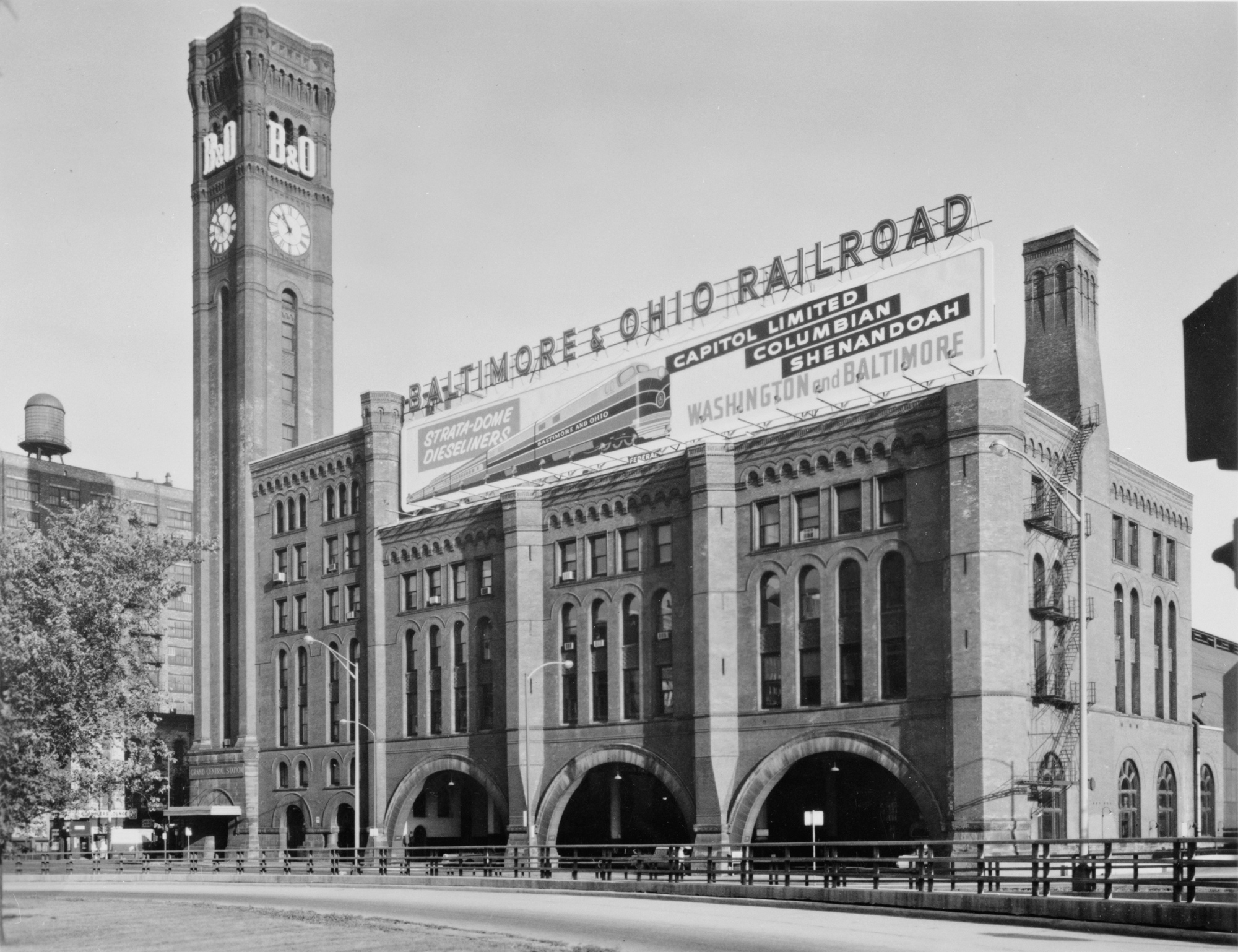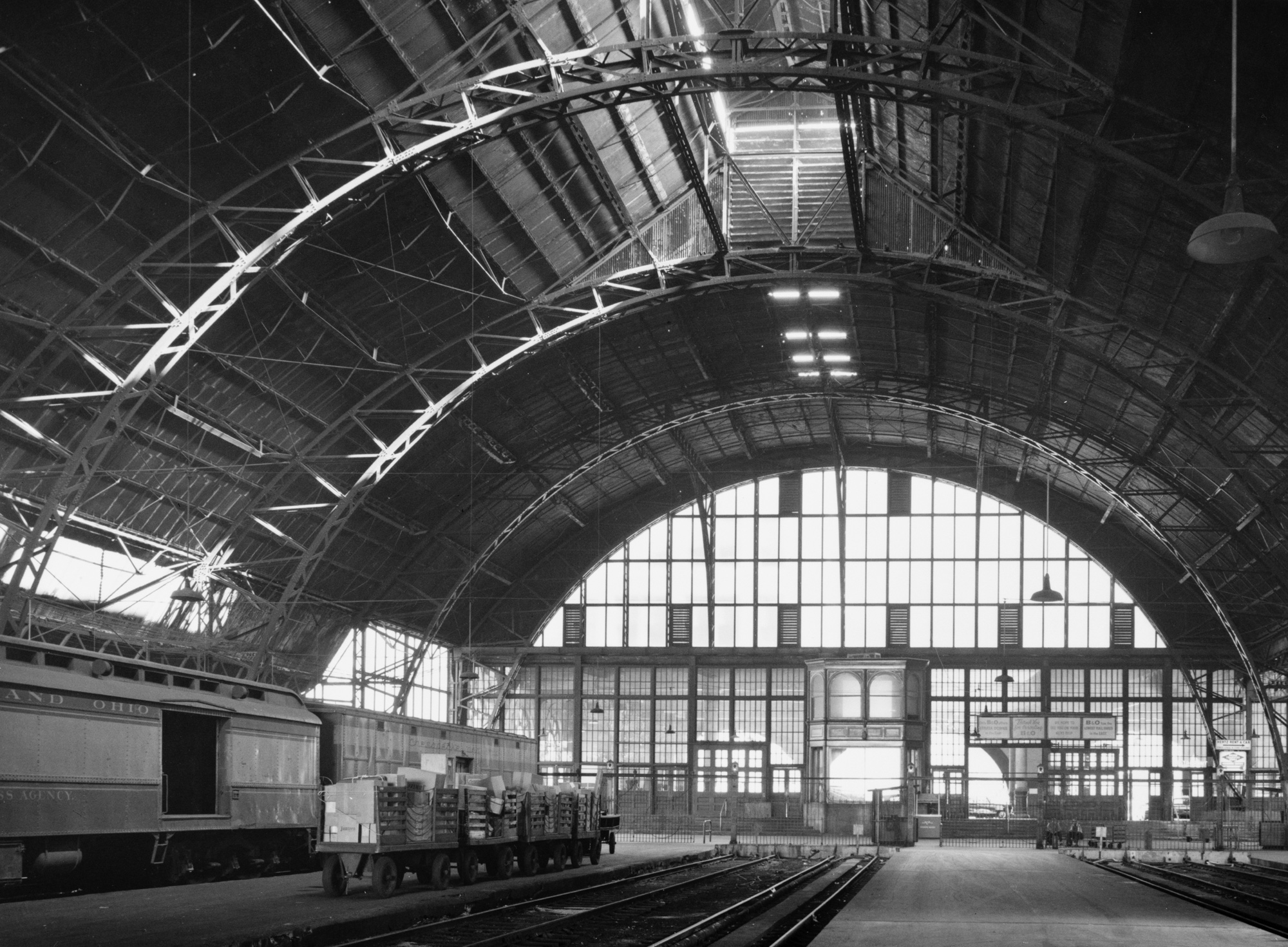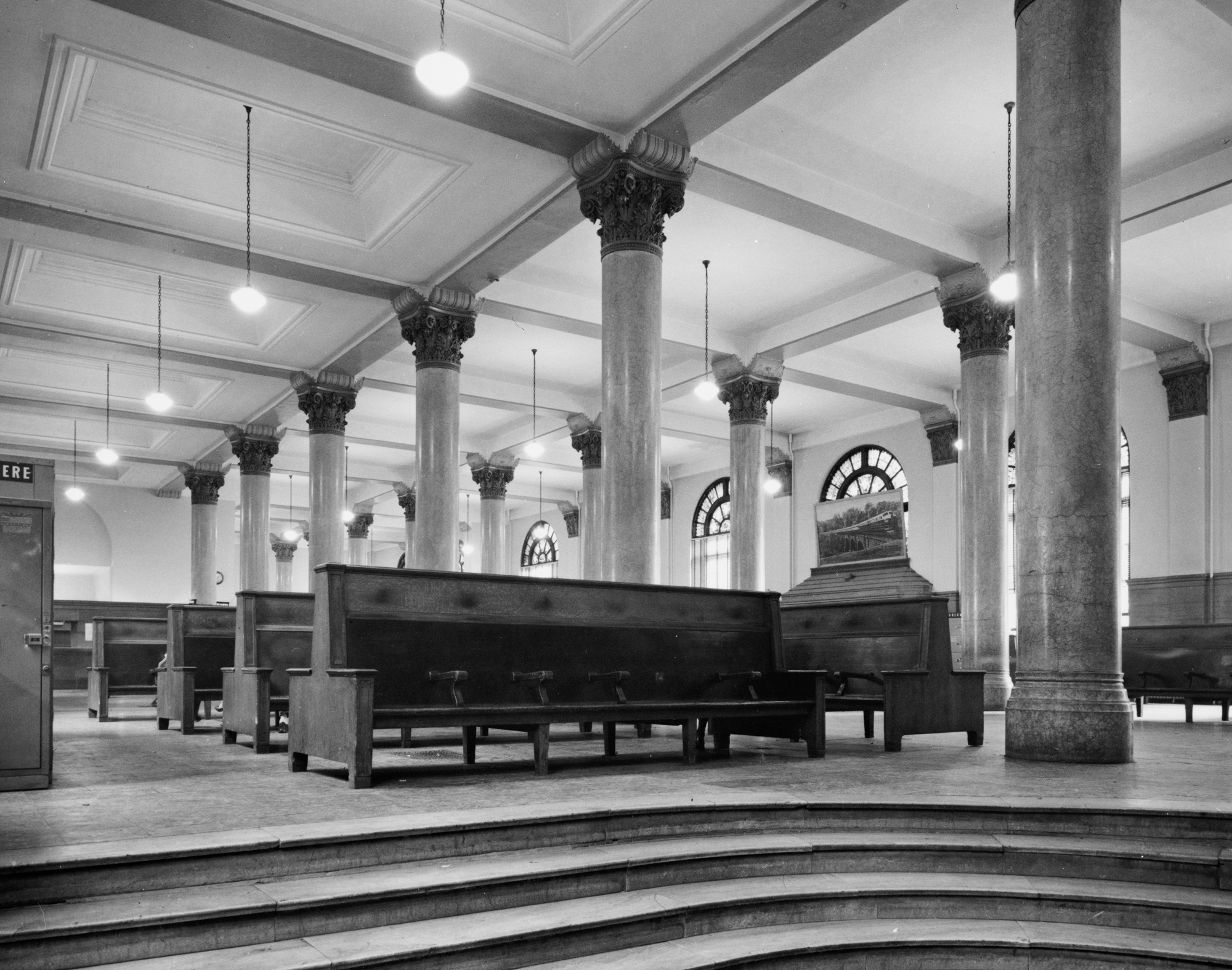Grand Central Station (Chicago): History, Photos, Overview
Last revised: February 27, 2025
By: Adam Burns
Chicago's Grand Central Station is one of the city's great railroad terminals, despite the fact that it is sometimes forgotten
due to the fact that it was destroyed before Amtrak even began.
The station was the smallest such facility in the city, used by the fewest railroads (just a handful served the terminal) although its impressive interior and exterior architecture overshadows these setbacks.
While it was not constructed by the Baltimore & Ohio Railroad it nevertheless became the eastern trunk line's link to Chicago and one its most prominent stations (from a public standpoint).
Grand Central was built in the late 19th century and its original owners had lavish plans for the facility until bankruptcy ended such ideas.
The terminal never reached its full potential and saddest of all, was razed in 1971 without much forethought.
Perhaps most ironic, in a city of constant development and a population of nearly 3 million, since the building's destruction more than 40 years ago the land on which it was located is still remains mostly empty.
The history of Chicago's Grand Central Station (not be confused with the New York Central's original Grand Central Station in New York City) dates back to October of 1889.
At this time the Chicago & Northern Pacific Railroad, then a subsidiary of the Wisconsin Central (itself owned by the Northern Pacific Railway) began construction of a new passenger terminal located along Harrison Street in the city's Southside.
At the time, the NP had plans to reach Chicago directly, given the city's importance and wanted a new station to showcase its entrance into the region.
As such, it would not only have provided the railroad with more efficient freight operations but also allowed the NP to move passengers trains over its own rails all of the way into the Windy City.
Grand Central Station was designed by architect Solon S. Beman, which built the terminal in the Norman Castellated style.
Bemen constructed the building using brownstone and granite although the exterior primarily consisted of red brick. Despite the general materials used it was still a lavish terminal, featuring arches and exterior columns that almost gave it a castle-like look.
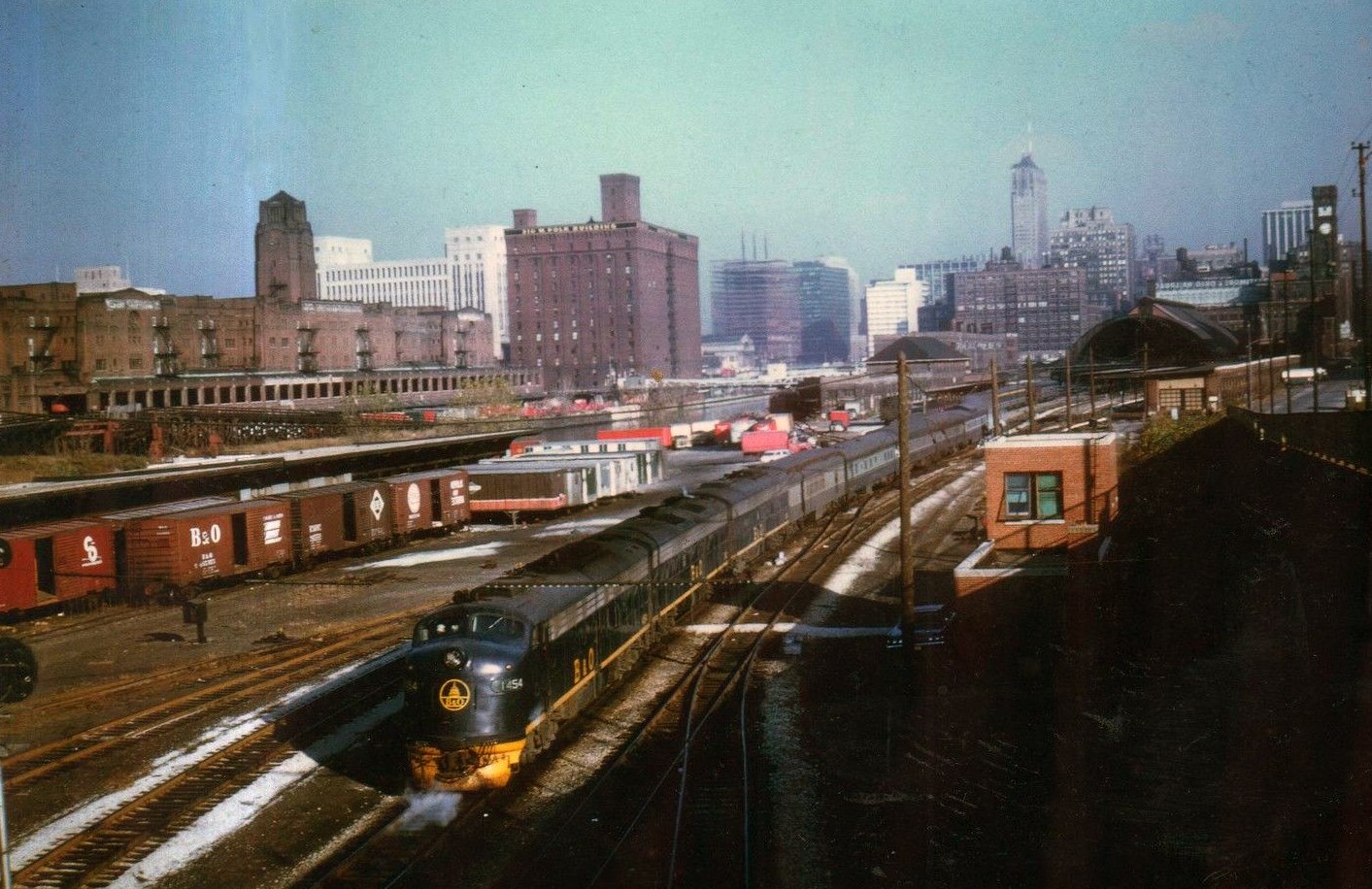 Baltimore & Ohio E9A #1454 (built as #34) leads train #6, the eastbound "Capitol Limited" (Chicago - Baltimore/Washington) out of the Windy City's Grand Central Station (the building with the clock tower on the far right) in the 1960s.
Baltimore & Ohio E9A #1454 (built as #34) leads train #6, the eastbound "Capitol Limited" (Chicago - Baltimore/Washington) out of the Windy City's Grand Central Station (the building with the clock tower on the far right) in the 1960s.The building's overall dimensions were 228 feet wide and 482 feet long with more than 110,000 square feet of interior space.
However, the station's most impressive feature was its beautiful
247-foot clock tower whose magnificent timepiece kept accurate time
through the end and at during its early years featured a bell, which
rang on each hour.
From an interior standpoint the station was given equal grandeur. It featured marble floors, a marble fireplace, Corinthian-style columns that stood 26-feet high, stained-glass windows, and elegant high-wood benches.
During the terminal's early years of operation it housed a restaurant on the ground floor and an impressive hotel in the above stories.
Additionally, the attached train shed was 555 feet long, 156 feet wide, and 78 feet high with much of the structure encased in glass allowing for plenty of light to flow through.
Grand Central opened to the general public on December 8, 1890, the second-oldest second-generation passenger terminal in Chicago (the oldest being Dearborn Station constructed in 1883).
While the Chicago & Northern Pacific ferried Wisconsin Central passenger trains to and from the terminal, Grand Central also played host to trains of:
- Baltimore & Ohio
- Chicago Great Western (via its subsidiary, the Minnesota & Northwestern Railroad)
- Pere Marquette Railway
- Minneapolis, St. Paul & Sault Ste. Marie Railway (Soo Line)
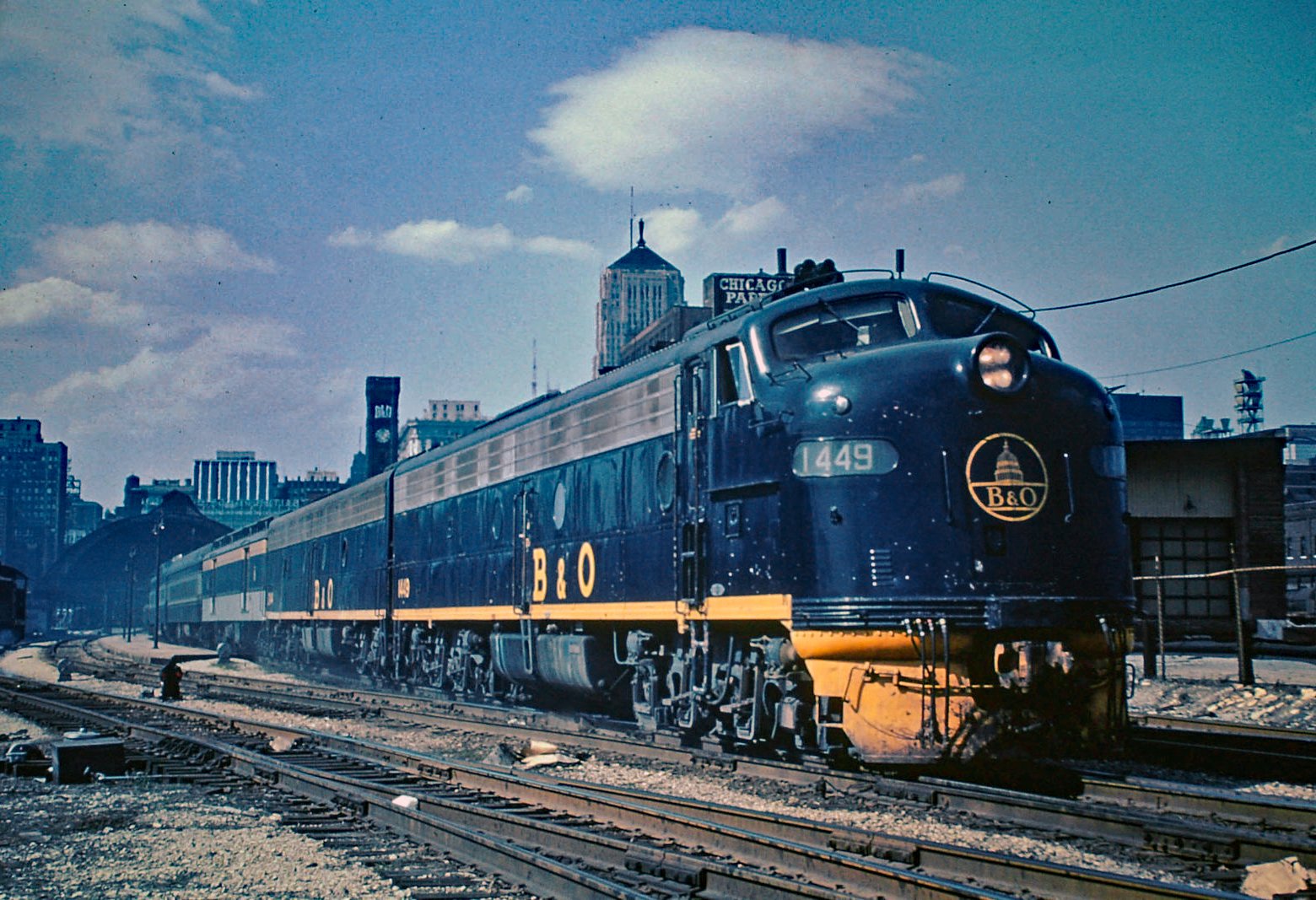 Baltimore & Ohio E8A #1449 departs Chicago's Grand Central Station with the railroad's flagship, the "Capitol Limited," in June, 1967. This facility was razed during the 1970's.
Baltimore & Ohio E8A #1449 departs Chicago's Grand Central Station with the railroad's flagship, the "Capitol Limited," in June, 1967. This facility was razed during the 1970's.Unfortunately for the Northern Pacific, the Financial Panic of 1893 forced the railroad into bankruptcy which ended its dreams of a direct route into Chicago.
Despite attempts to hold onto to its Chicago area properties, alas Grand Central Station was sold at foreclosure to the B&O in 1910.
The eastern trunk line made the station uniquely its own by later adding a neon-lit "B&O" sign in the bell tower, providing for a beautiful photographic setting of trains awaiting departure just outside the train shed with the sign glowing brightly in the background.
Additionally, the trackage the railroad gained from the transaction became another part of its Baltimore and Ohio Chicago Terminal Railroad.
While the station was architecturally beautiful, with only one major railroad serving the building (the Soo and Chicago Great Western were both regional, Midwestern systems) it was never as busy as the five other major terminals serving the Chicago.
During peak operations from its opening through the 1920s (and later during World War II) the station averaged just 38 trains per day with just under 4,000 daily passengers.
In comparison the terminal saw just 10% of Central Station's (owned by Illinois Central) daily trains and was well behind fifth-busiest Dearborn Station's 146 trains-per-day.
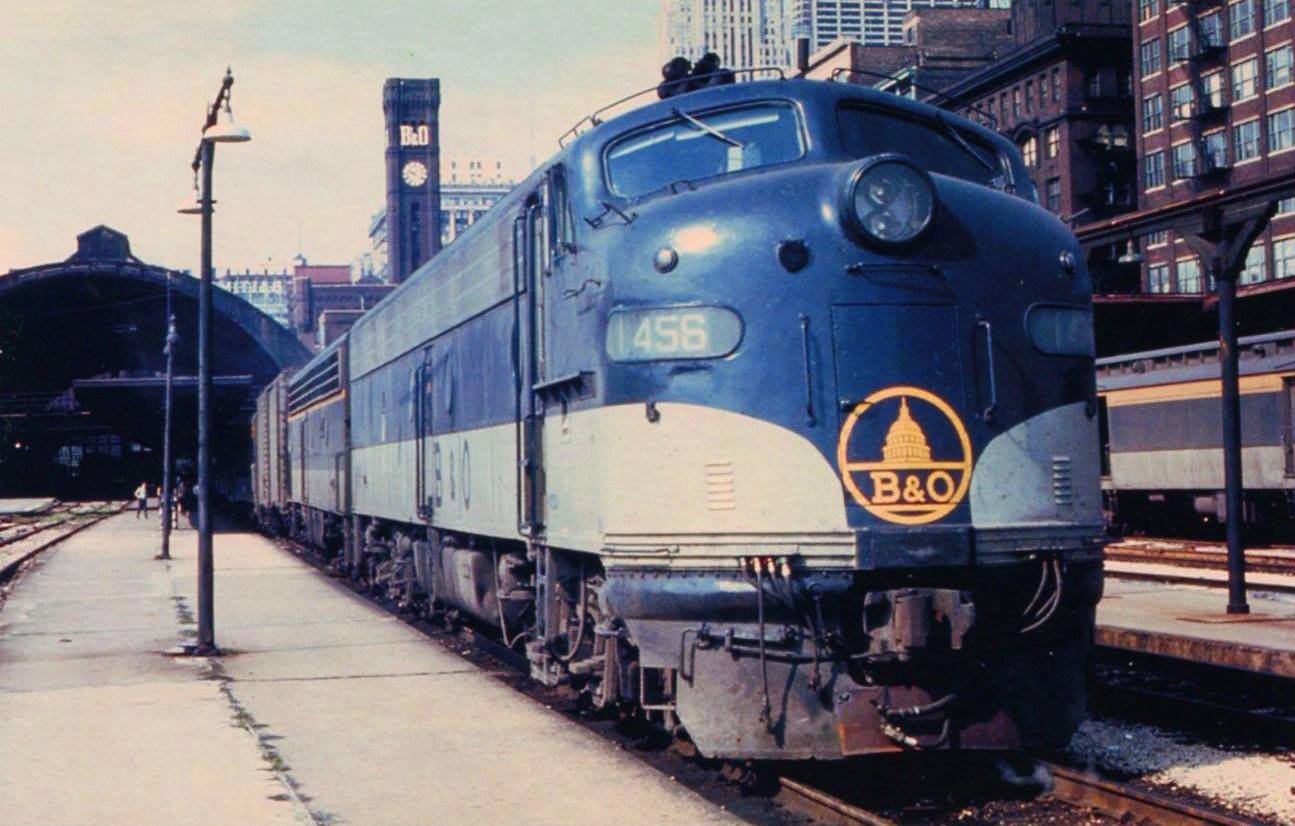 Baltimore & Ohio E9A #1456 (ex-#38) awaits departure from Chicago's Grand Central Station in the 1960's. The facility was razed in the 1970's.
Baltimore & Ohio E9A #1456 (ex-#38) awaits departure from Chicago's Grand Central Station in the 1960's. The facility was razed in the 1970's.Still, one could find several storied streamliners calling to Grand Central including the B&O's flagship Capitol Limited as well as other named trains like the Columbian and Shenandoah.
In addition, the Soo Line's Laker could regularly be found at the terminal as could the CGW's Great Western Limited, Legionnaire, and Minnesotan.
Finally, the Pere Marquette's Grand Rapids Flyer and Grand Rapids Express both called to the station. As passenger rail serviced waned following World War II so did business at Grand Central Station.
By 1956 the Chicago Great Western stopped using the facility and by the early 1960s only the owner, Baltimore & Ohio remained with the grand station seeing just a paltry 210 passengers daily.
In a surprising move, somewhat uncharacteristic of the B&O (which became known for saving historic structures and equipment) the company elected to raze Grand Central Station in 1971 to sell the perceived-valuable land beneath it.
In addition, the terminal had no future rail value as the city of Chicago was urging the region's railroads to consolidate facilities in preparation for Amtrak.
Amazingly, the ground failed to sell, for decades. It was thought the property would be prime for new condos, apartments, and office buildings but ultimately none of this came to be.
The Baltimore & Ohio retained the property through the Chessie System era and later when CSX Transportation was created in 1987. Only in 2008 did the ground finally sell to a real estate agent.
Recent Articles
-
Maryland's - Wine Tasting - Train Rides
Jan 15, 26 02:59 PM
This article delves into the enchanting world of wine tasting train experiences in Maryland, providing a detailed exploration of their offerings, history, and allure. -
Colorado's - Wine Tasting - Train Rides
Jan 15, 26 02:46 PM
To truly savor these local flavors while soaking in the scenic beauty of Colorado, the concept of wine tasting trains has emerged, offering both locals and tourists a luxurious and immersive indulgenc… -
Iowa ~ Wine Tasting ~ Train Rides
Jan 15, 26 02:36 PM
The state not only boasts a burgeoning wine industry but also offers unique experiences such as wine by rail aboard the Boone & Scenic Valley Railroad. -
Georgia's Wine Train Rides In Cordele!
Jan 15, 26 02:26 PM
While the railroad offers a range of themed trips throughout the year, one of its most crowd-pleasing special events is the Wine & Cheese Train—a short, scenic round trip designed to feel like a t… -
Indiana ~ Murder Mystery ~ Dinner Train Rides
Jan 15, 26 02:22 PM
This piece explores the allure of murder mystery trains and why they are becoming a must-try experience for enthusiasts and casual travelers alike. -
Ohio ~ Murder Mystery ~ Dinner Train Rides
Jan 15, 26 02:10 PM
The murder mystery dinner train rides in Ohio provide an immersive experience that combines fine dining, an engaging narrative, and the beauty of Ohio's landscapes. -
Nevada Dinner Train Rides In Ely!
Jan 15, 26 02:01 PM
If you’ve ever wished you could step through a time portal into the hard-working world of a 1900s short line the Nevada Northern Railway in Ely is about as close as it gets. -
Michigan Dinner Train Rides In Owosso!
Jan 15, 26 09:46 AM
The Steam Railroading Institute is best known as the home of Pere Marquette #1225 and even occasionally hosts a dinner train! -
Arizona's - Wine Tasting - Train Rides
Jan 14, 26 02:04 PM
For those who want to experience the charm of Arizona's wine scene while embracing the romance of rail travel, wine tasting train rides offer a memorable journey through the state's picturesque landsc… -
Arkansas's - Wine Tasting - Train Rides
Jan 14, 26 01:57 PM
This article takes you through the experience of wine tasting train rides in Arkansas, highlighting their offerings, routes, and the delightful blend of history, scenery, and flavor that makes them so… -
Tennessee ~ Murder Mystery ~ Dinner Train Rides
Jan 14, 26 01:42 PM
Amidst the rolling hills and scenic landscapes of Tennessee, an exhilarating and interactive experience awaits those with a taste for mystery and intrigue. -
California ~ Murder Mystery ~ Dinner Train Rides
Jan 14, 26 01:26 PM
When it comes to experiencing the allure of crime-solving sprinkled with delicious dining, California's murder mystery dinner train rides have carved a niche for themselves among both locals and touri… -
Illinois ~ Murder Mystery ~ Dinner Train Rides
Jan 14, 26 01:13 PM
Among Illinois's scenic train rides, one of the most unique and captivating experiences is the murder mystery excursion. -
Vermont's - Murder Mystery - Dinner Train Rides
Jan 14, 26 12:57 PM
There are currently murder mystery dinner trains offered in Vermont but until recently the Champlain Valley Dinner Train offered such a trip! -
Massachusetts Dinner Train Rides On Cape Cod!
Jan 14, 26 12:20 PM
The Cape Cod Central Railroad (CCCR) has carved out a special niche by pairing classic New England scenery with old-school hospitality, including some of the best-known dining train experiences in the… -
Maine Dinner Train Rides In Portland!
Jan 14, 26 11:31 AM
While this isn’t generally a “dinner train” railroad in the traditional sense—no multi-course meal served en route—Maine Narrow Gauge does offer several popular ride experiences where food and drink a… -
Kentucky Dinner Train Rides In Bardstown!
Jan 13, 26 01:14 PM
The essence of My Old Kentucky Dinner Train is part restaurant, part scenic excursion, and part living piece of Kentucky rail history. -
Kansas Dinner Train Rides In Abilene!
Jan 13, 26 12:44 PM
If you’re looking for a heritage railroad that feels authentically Kansas—equal parts prairie scenery, small-town history, and hands-on railroading—the Abilene & Smoky Valley Railroad (A&SV) delivers. -
Michigan ~ Murder Mystery ~ Dinner Train Rides
Jan 13, 26 11:24 AM
Among the lesser-known treasures of this state are the intriguing murder mystery dinner train rides—a perfect blend of suspense, dining, and scenic exploration. -
Virginia's - Murder Mystery - Dinner Train Rides
Jan 13, 26 11:11 AM
Among the state's railroad attractions, murder mystery dinner trains stand out as a captivating fusion of theatrical entertainment, fine dining, and scenic travel. -
Arizona Dinner Train Rides At The Grand Canyon!
Jan 13, 26 10:59 AM
While the Grand Canyon Railway does not offer a true, onboard dinner train experience it does offer several upscale options and off-train dining. -
Georgia Dinner Train Rides In Nashville!
Jan 13, 26 10:27 AM
If you’ve ever wished you could slow down, trade traffic for jointed rail, and let a small-town landscape roll by your window while a hot meal is served at your table, the Azalea Sprinter delivers tha… -
Indiana Valentine's Train Rides
Jan 12, 26 04:27 PM
If you’ve ever wished you could step into a time when passenger trains were a Saturday-night treat and a whistle echoing across farm fields meant “adventure,” the Nickel Plate Express delivers that fe… -
Ohio Valentine's Train Rides!
Jan 12, 26 04:20 PM
The Hocking Valley Scenic Railway offers one of the region’s most atmospheric ways to experience the Hocking Hills area: from the rhythmic click of jointed rail to the glow of vintage coaches rolling… -
Wisconsin's - Wine Tasting - Train Rides
Jan 12, 26 03:10 PM
Wisconsin might not be the first state that comes to mind when one thinks of wine, but this scenic region is increasingly gaining recognition for its unique offerings in viticulture. -
California's - Wine Tasting - Train Rides
Jan 12, 26 02:34 PM
This article explores the charm, routes, and offerings of these unique wine tasting trains that traverse California’s picturesque landscapes. -
Wisconsin Scenic Train Rides In North Freedom!
Jan 12, 26 02:20 PM
The Mid-Continent Railway Museum is a living-history museum built around the sights, sounds, and everyday rhythms of small-town and shortline railroading in the early 20th century, what the museum cal… -
Vermont Scenic Train Rides In Burlington!
Jan 12, 26 01:18 PM
Today, GMRC is best known by many travelers for its Burlington-based passenger experiences—most famously the Champlain Valley Dinner Train and the sleek, limited-capacity Cocktails on the Rails. -
Maryland's - Murder Mystery - Dinner Train Rides
Jan 12, 26 01:03 PM
Maryland is known for its scenic landscapes, historical landmarks, and vibrant culture, but did you know that it’s also home to some of the most thrilling murder mystery dinner trains? -
Minnesota's - Murder Mystery - Dinner Train Rides
Jan 12, 26 12:17 PM
Murder mystery dinner trains offer an enticing blend of suspense, culinary delight, and perpetual motion, where passengers become both detectives and dining companions on an unforgettable journey. -
Vermont Dinner Train Rides In Burlington!
Jan 12, 26 12:09 PM
There is one location in Vermont hosting a dedicated dinner train experience at the Green Mountain Railroad. -
Connecticut Dinner Train Rides In Essex!
Jan 12, 26 10:39 AM
Connecticut's rail heritage can be traced back to the industry's earliest days and a few organizations preserve this rich history by offering train rides. The Essex Steam Train also hosts dinner-theme… -
Florida Scenic Train Rides In Parrish!
Jan 11, 26 10:26 PM
The Florida Railroad Museum (FRRM) in Parrish offers something increasingly rare in today’s rail landscape: a chance to ride historic equipment over a surviving fragment of an early-20th-century mainl… -
California's - Wine Tasting - Train Rides
Jan 11, 26 02:28 PM
This article explores the charm, routes, and offerings of these unique wine tasting trains that traverse California’s picturesque landscapes. -
Georgia's - Murder Mystery - Dinner Train Rides
Jan 11, 26 02:07 PM
In the heart of the Peach State, a unique form of entertainment combines the thrill of a murder mystery with the charm of a historic train ride. -
Colorado ~ Murder Mystery ~ Dinner Train Rides
Jan 11, 26 01:43 PM
Nestled among the breathtaking vistas and rugged terrains of Colorado lies a unique fusion of theater, gastronomy, and travel—a murder mystery dinner train ride. -
Minnesota Dinner Train Rides In Duluth!
Jan 11, 26 01:32 PM
One of the best ways to feel the region's history in motion today is aboard the North Shore Scenic Railroad (NSSR), which operates out of Duluth’s historic depot. -
Illinois Dinner Train Rides At Monticello!
Jan 11, 26 12:42 PM
The Monticello Railway Museum (MRM) is one of those places that quietly does a lot: it preserves a sizable collection, maintains its own operating railroad, and—most importantly for visitors—puts hist… -
Alabama's - Wine Tasting - Train Rides
Jan 10, 26 09:29 AM
While the state might not be the first to come to mind when one thinks of wine or train travel, the unique concept of wine tasting trains adds a refreshing twist to the Alabama tourism scene. -
Maryland Dinner Train Rides At WMSR!
Jan 10, 26 09:13 AM
The Western Maryland Scenic Railroad (WMSR) has become one of the Mid-Atlantic’s signature heritage operations—equal parts mountain railroad, living museum, and “special-occasion” night out. -
Arkansas Dinner Train Rides On The A&M!
Jan 10, 26 09:11 AM
If you want a railroad experience that feels equal parts “working short line” and “time machine,” the Arkansas & Missouri Railroad (A&M) delivers in a way few modern operations can. -
South Dakota's - Murder Mystery - Dinner Train Rides
Jan 10, 26 09:08 AM
While the state currently does not offer any murder mystery dinner train rides, the popular "1880 Train" at the Black Hills Central recently hosted these popular trips! -
Wisconsin's - Murder Mystery - Dinner Train Rides
Jan 10, 26 09:07 AM
Whether you're a fan of mystery novels or simply relish a night of theatrical entertainment, Wisconsin's murder mystery dinner trains promise an unforgettable adventure. -
Missouri's - Murder Mystery - Dinner Train Rides
Jan 10, 26 09:05 AM
Missouri, with its rich history and scenic landscapes, is home to one location hosting these unique excursion experiences. -
Washington ~ Murder Mystery ~ Dinner Train Rides
Jan 10, 26 09:04 AM
This article delves into what makes murder mystery dinner train rides in Washington State such a captivating experience. -
Kentucky Scenic Train Rides At KRM!
Jan 09, 26 11:13 PM
Located in the small town of New Haven the Kentucky Railway Museum offers a combination of historic equipment and popular excursions. -
Washington "Wine Tasting" Train Rides
Jan 09, 26 08:53 PM
Here’s a detailed look at where and how to ride, what to expect, and practical tips to make the most of wine tasting by rail in Washington. -
Kentucky's - Wine Tasting - Train Rides
Jan 09, 26 08:21 PM
Kentucky, often celebrated for its rolling pastures, thoroughbred horses, and bourbon legacy, has been cultivating another gem in its storied landscapes; enjoying wine by rail. -
Kentucky's - Murder Mystery - Dinner Train Rides
Jan 09, 26 01:12 PM
In the realm of unique travel experiences, Kentucky offers an enchanting twist that entices both locals and tourists alike: murder mystery dinner train rides. -
Utah's - Murder Mystery - Dinner Train Rides
Jan 09, 26 01:05 PM
This article highlights the murder mystery dinner trains currently avaliable in the state of Utah!

